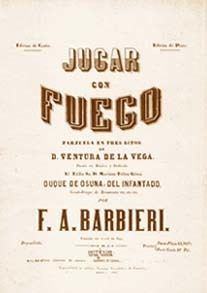 | ||
Similar Los diamantes de la coro, El barberillo de Lavapi, Doña Francisquita, Luisa Fernanda, The Troublemaker | ||
Sms jugar con fuego official video hd by pedro vazquez
Jugar con fuego (Playing with fire) is a zarzuela in three acts by Francisco Asenjo Barbieri. The libretto, in Spanish, is by Ventura de la Vega. The first performance took place at the Teatro del Circo in Madrid on 6 October 1851, and it became one of the most well-known zarzuelas. The title refers to how dangerous it is to play with love.
Contents
- Sms jugar con fuego official video hd by pedro vazquez
- Santaflow jugar con fuego
- Background
- Synopsis
- Act I
- Act II
- Act III
- References
Santaflow jugar con fuego
Background
This work is a landmark in the history of Spanish opera, being the first notable example of a zarzuela in three acts, close to the model of the opéra comique, although Barbieri is still writing influenced by Italian opera composers of the time.
The plot of the play by Ventura de la Vega is based on Madame d'Egmont, ou Sont-elles deux? by Jacques-François Ancelot and Alexis Decombereusse, which was first performed on 25 April 1833 at the Théâtre des Variétés in Paris.
The 1954 Novoson recording of Jugar con fuego conducted by Ataúlfo Argenta, with Pilar Lorengar, Manuel Ausensi, Carlos Munguia and Antonio Campo, was reissued on CD in 1990.
The Act 3 romanza "Un tiempo fue" for the Duchess, repentant and in finally truly in love, is the most famous number of the score.
Synopsis
During the reign of Philip V of Spain
Act I
Among the throng of the verbenera at mid-summer night of San Juan on the banks of the Manzanares the nobility mingle with pedlars and artisans. The crowd recognises the Duchess of Medina, a young widow who has disguised herself as a poor house-maid for an assignation with her admirer, but pursued by the Marqués of Caravaca, a boastful and lecherous man. He is secretly trying to discover who is following her and importunes her putting paid to her adventure, until her father also appears, which allows her to disappear into the crowd again. Félix and Antonio, poverty-stricken hidalgos enter, the former hoping for a meeting with a lady who calls herself Leonor; eventually she emerges from the throng and they exchange conversation in a duo. While Félix goes to find a carriage for his young lady the Marqués interferes with several of his friends, to which the Duke responds, defending her honour. While Félix, having helped 'Leonor' flee, is bemused by the events, the crowd mock the aristocrats.
Act II
In a hall of the Palacio del Buen Retiro the Duchess of Medina tell her friend of her escape from the verbena. The Marqués enters and threatens the Duchess with his suspicions about whom she was talking to at the festival. Félix and his cousin arrive at the royal palace. At first refused entry because of their rustic appearance, the Marqués enquiries about Félix's love affairs. The young man is amazed to see and recognize the Duchess; the Marqués presents and observes their awkward behaviour. Félix is made to believe that he has been deceived by the Duchess and shows the Marqués one of her letters. The Duchess is now forced into accepting to wed the Marqués, all the while vowing to outwit her adversary. When he draws his sword and confronts her, Félix is condemned as being crazy and the Duke send him off to a madhouse.
Act III
In the courtyard of the madhouse, Félix awaits a visit from Antonio who tells him that he may be released if he signs an admission of his mistakes. The two men go inside as the Countess and Duchess enter, planning to free her lover; the latter sings of her repentance. When Félix emerges she admits everything to him. The Marqués arrives and is directed to a veiled woman inside but is attacked by inmates and has his clothes taken off him. Félix, Antonio and the Duchess make their escape but are blocked by the Duke who threatens them both, only to relent when the Countess brings a royal order authorizing the marriage of Félix and the Duchess. Marqués enters asking for help but is ignored, and all ends happily.
